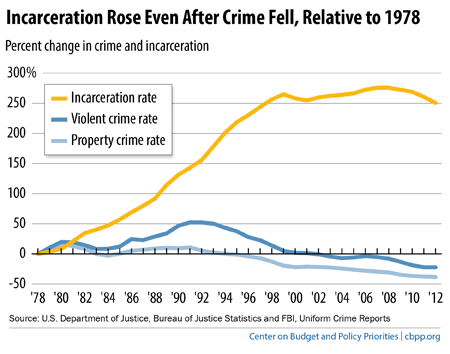BEYOND THE NUMBERS
Increased incarceration has contributed next to nothing to the sharp drop in crime over the past 25 years, a recent Brennan Center for Justice report finds. This research, along with other recent analysis challenging the belief that incarcerating a bigger share of offenders and for longer periods would significantly reduce crime, suggests that states would be better off spending less on locking people up and more on education, mental health, and substance abuse treatment.
As our report on criminal justice reform explains, most states’ prison populations are at historic highs; in 36 states, the prison population has more than tripled as a share of state population since 1978 (see graph). This growth has been costly. If states were still spending on corrections what they spent in the mid-1980s, adjusted for inflation, they would have about $28 billion more each year to spend on more productive investments or a mix of investments and tax reductions.

The Brennan Center report found that while rising incarceration rates helped reduce property and violent crime rates in the 1990s, the effect was much smaller than some other studies have suggested, accounting for 0-10 percent of the total decline over the decade. Since 2000, rising incarceration rates account for less than 1 percent of the decline in crime rates.
“This report’s analysis reveals that incarceration has been decreasing as a crime fighting tactic since at least 1980,” the authors conclude. “Since approximately 1990, the effectiveness of increased incarceration on bringing down crime has been essentially zero.” Factors such as an aging population, higher earnings, lower alcohol consumption, and smarter police tactics may have done as much or more to reduce crime, according to the study.
We’ve outlined four basic ways that states can reduce their prison populations to free up funds for schools and other investments in human capital: decriminalize and reclassify certain low-level felonies, shorten prison terms and parole/probation periods, restrict the use of prison for parole violations, and divert people with mental health and substance abuse issues out of the system altogether.
